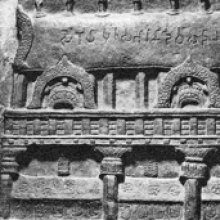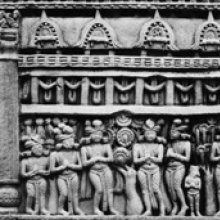Cankrama, Caṅkramā: 10 definitions
Introduction:
Cankrama means something in Buddhism, Pali, Hinduism, Sanskrit, the history of ancient India. If you want to know the exact meaning, history, etymology or English translation of this term then check out the descriptions on this page. Add your comment or reference to a book if you want to contribute to this summary article.
Alternative spellings of this word include Chankrama.
Images (photo gallery)
In Buddhism
Mahayana (major branch of Buddhism)
Source: Wisdom Library: Maha Prajnaparamita SastraCaṅkrama (चङ्क्रम) refers to “walking”, according to Mahāprajñāpāramitāśāstra (chapter 31).—Accordingly, “[...] Recent suffering (navaduḥkha) is ‘happiness’ (sukha) [in contrast] to the old suffering (pūrvaduḥkha) which is ‘suffering’. Thus, when one sits down one feels happiness, but when this position persists, it gives rise to suffering. At the beginning, walking [i.e., caṅkrama], standing and lying down are happiness, but in the end they too are suffering. Whether one is bending or one is stretching, whether one is bowing the head or raising it, whether one looks straight ahead or to the side, whether one is breathing out or breathing in, suffering always follows the body. From conception and birth to death, there is not a single moment of happiness”.

Mahayana (महायान, mahāyāna) is a major branch of Buddhism focusing on the path of a Bodhisattva (spiritual aspirants/ enlightened beings). Extant literature is vast and primarely composed in the Sanskrit language. There are many sūtras of which some of the earliest are the various Prajñāpāramitā sūtras.
India history and geography
Source: Cologne Digital Sanskrit Dictionaries: Indian Epigraphical GlossaryCaṅkrama.—(LL), Prakrit caṃkama (EI 24); a promenade, a walk. Note: caṅkrama is defined in the “Indian epigraphical glossary” as it can be found on ancient inscriptions commonly written in Sanskrit, Prakrit or Dravidian languages.

The history of India traces the identification of countries, villages, towns and other regions of India, as well as mythology, zoology, royal dynasties, rulers, tribes, local festivities and traditions and regional languages. Ancient India enjoyed religious freedom and encourages the path of Dharma, a concept common to Buddhism, Hinduism, and Jainism.
Languages of India and abroad
Sanskrit dictionary
Source: DDSA: The practical Sanskrit-English dictionaryCaṅkramā (चङ्क्रमा).—Going or moving about, walking.
Source: Cologne Digital Sanskrit Dictionaries: Edgerton Buddhist Hybrid Sanskrit DictionaryCaṅkrama (चङ्क्रम).—m. and (less regularly) nt. (= Pali caṅkama; to caṅkramati), (1) act of walking, in purely physical sense: vivṛtaḥ śobhate ārya āsana-sthāna-caṅ- krame Lalitavistara 157.15 (verse), when uncovered (unveiled), a noble person shines (is distinguished) in sitting, standing, and walking; these are three of the (usually four) modes of physical behavior (the fourth being lying down), see s.v. īryāpatha 4; Aṣṭasāhasrikā-prajñāpāramitā 520.13; Rāṣṭrapālaparipṛcchā 45.18; cognate acc. °maṃ caṅkramyate or °mati, see (4) below; (2) walking, wander- ing, as an occupation or mode of life: in Karmavibhaṅga (and Karmavibhaṅgopadeśa) 104.14 one of the daśa guṇāḥ paiṇḍapātikatve, ten advantages in the mendicant's life, is, caṅkramo 'sya upārjito bhavati, he has acquired (a life of) walking, wandering about; (3) place of walking, promenade (in the sense of ground where walking is done): of walks in groves or parks (secular), ekaikaṃ caṅkrama-varaṃ…kalpayatha Mahāvastu ii.18.16 (verse), Śuddhodana says, adorn (or with mss. kalpayama, let us adorn) every excellent promenade (in the Lumbinī grove, in preparation for Māyā's visit); gṛha-dhana-dhānya- śayana-vasanaṃ caṅkramodyānāni cānekaśo yācanake- bhyo nisṛṣṭāni Lalitavistara 318.5 (prose),…promenades and parks were bestowed on beggars many times; (4) especially, prome- nade, terrace, place for walking (often rendered cloister), for monks or Buddhas or other ascetics; sometimes as- sociated with places for ‘standing, sitting, lying down’, the other īryāpatha, see meaning (1) above: samyaksaṃ- buddhānāṃ adhiṣṭhitāni caṅkramā niṣadyāni śayyāni Mahāvastu ii.163.18; teṣāṃ bhikṣūṇāṃ sthānāni caṅkramāṇi niṣadyāni śayyāni Mahāvastu iii.420.15; teṣu ca caṅkrameṣu niṣadyāsv āsaneṣu ca Gaṇḍavyūha 518.7 (places); oftener associated [Page222-a+ 71] with a vihāra (from which it seems that one climbed or mounted to the caṅkrama, compare Pali Theragāthā (Pali) 271…vihārā upanikkhamiṃ, caṅkamam abhirūhanto; so frequently abhi-ruh- occurs in [Buddhist Hybrid Sanskrit] with this word): araṇyavāsi (loc.; v.l. °se) tiṣṭhanto caṅkrame (WT °mam with Ḱ) abhiruhya ca Saddharmapuṇḍarīka 335.5 (verse); ārāmāś caṅkramā dattāḥ (to Buddha and his monks) 341.13 (verse); ye keci bhikṣū sugatasya śāsane, abhiyuktarūpā sthita caṅkrameṣu 365.5 (verse); (yasmiṃś ca…grāme vā nagare vā…) janapada- pradeśe vā caṅkrame vā vihāre vā ayaṃ Lalitavistaro… pracariṣyati Lalitavistara 442.11; bhikṣŭṇāṃ saptaratnacitān vi- hārān kārayām āsa maṇi-caṅkramān (probably Karmadh., not [bahuvrīhi])…Rāṣṭrapālaparipṛcchā 56.13; in Mahāvastu i.318.10 text, bhagavato Kāśyapasya caṅkrama-ṣaṣṭiḥ, for which Senart's note suggests caṅkrama-bhūmiḥ (violent em.!), but mss. kraṃkrame (or kraṃkame) ṣa°; possibly read caṅkrame yaṣṭiḥ, stick (pole, flagstaff?) in K's promenade; (vihārān…) ārāmān ramaṇīyāṃś ca caṅkrama-sthāna-śobhitān Saddharmapuṇḍarīka 334.9 (verse; ca°-sthāna, place of promenade, substantially = caṅkrama?); (vihārāḥ…bhikṣusahasrāvāsā ārāmapuṣpo- paśobhitāś) caṅkramavanopetāḥ Saddharmapuṇḍarīka 339.3,…provided with promenades and groves; of a brahmanical ascetic, atha Brahmaprabho māṇavako 'nyatarasmin pradeśe kuṭīṃ kārayitvā caṅkramaṃ (a walking-ground, in the wilds) pratiṣṭhāpya sattvānām arthāya tapas taptavān Divyāvadāna 477.17—19; (Bhagavataś) caṅkrame dattaḥ (sc. pradīpaḥ) Divyāvadāna 90.3, a lamp was given to the Lord on his promenade (i.e. the place of exercise ? or on his walk, to meaning 1 ?); loc. or acc., followed by form of the cognate verb, bhagavāṃś cāsya nātidūre caṅkrame caṅkramyate Avadāna-śataka i.183.1; ānando bahir vihārasyābhyavakāśe caṅkrame caṅkramyate 228.9; (Buddha speaks) yan nūnāhaṃ pauruṣamātraṃ vaihāyasam antarīkṣe dīrghaṃ caṅkra- maṃ caṅkrameyaṃ Mahāvastu iii.114.12—13, which he does in 15, dī° ca° caṅkramati aspṛśanto pādatalehi bhūmiyaṃ; in a dream the Bodhisattva sees himself, tathāgato… saṃbodhim anabhisaṃbuddho mahato mīḍhaparvatasya uparim anupalipyamāno caṅkramaṃ caṅkrame (aor.) Mahāvastu ii.137.11—12 and 139.7—8; the long (-continued) promenade (compare Mahāvastu iii.114.12—13 above) seems to have been a special spiritual exercise, to which exceptional importance is attached, and the cognate accus. in the following may be partly a noun of action, tho it seems rarely if ever com- pletely separate from the place-designation; the Buddha, in the 2d or 3d week after enlightenment, (dvitīye) saptāhe tathāgato dīrghacaṅkramaṃ caṅkramyate sma Lalitavistara 377.4, (tṛtīyaṃ) saptāhaṃ prītisukhena dīrghaṃ caṅkramaṃ caṅkrame (aor.) Mahāvastu iii.281.12; (Buddha, vihārāto nir- gamya…smitaṃ prāduṣkaritvā) dīrghaṃ caṅkramaṃ caṅkrame (aor.) Mahāvastu i.317.(7—)9; without use of the word dīrgha, the like is presented in Saddharmapuṇḍarīka, with emphasis on spiritual results: (the Bodhisattva Sarvasattvapriyadar- śana) dvādaśa varṣasahasrāṇi caṅkramābhirūḍho (Tibetan ḥchag pa la zhugs śiṅ, having begun, undertaken, a walk) 'bhūn mahāvīryārambheṇa yogābhiyukto 'bhūt Saddharmapuṇḍarīka 405.13, followed by reference to this in 408.14 (verse), spoken by the Bodhisattva S., ayaṃ mamā caṅkrama rāja śreṣṭha yasmin mayā sthitva samādhi labdhaḥ; similarly, yadā ca sa dharmabhāṇako 'smin dharmaparyāye cintāyogam anuyuktaś caṅkramābhirūḍho bhaviṣyati, tadāhaṃ… tasya dharmabhāṇakasya caṅkrama-kuṭīm (Tibetan ḥchag paḥi, = caṅkrama, gnas, = place, especially abode, habitation; compare kuṭīṃ and caṅkramaṃ together in Divyāvadāna 477.17—19 above) upasaṃkramiṣyāmi (I will go to his promenade-hut which perhaps might be in a vihāra, but in any case must be the place where he rested during his caṅkrama with its long-continued attendant spiritual exercises)…asya dharmaparyāyasyārakṣāya Saddharmapuṇḍarīka 474.11—475.2; ye…eka- viṃśatidivasāni caṅkramābhirūḍhā abhiyuktā bhaviṣyanti, teṣām ahaṃ…ekaviṃśatime divase teṣāṃ dharma- bhāṇakānāṃ caṅkramam āgamiṣyāmy…Saddharmapuṇḍarīka 476.3—5 [Page222-b+ 71] (note here the evident reference to caṅkrama as a definite place!); in Kāraṇḍavvūha caṅkramaṇa, q.v., is used in the same local sense, but twice followed by caṅkrama in this same sense: tato vimānān niṣkramya svaka-svakāni caṅkra- maṇāni pratyudgatāḥ (sc. Bodhisattvāḥ), caṅkrame- caṅkrame…(follows description of their physical beauties and decorations) Kāraṇḍavvūha 65.1—2; (pious kiṃnaras) ṣaṭpāramitā- sāṃkathya(ṃ) kṛtvā svaka-svakāni caṅkramaṇāni caṅ- kramanti (compare cognate verb with caṅkrama, above); kecit suvarṇamayāś caṅkramā(s) teṣu caṅkrameṣu sāmantakeṣu kalpavṛkṣāḥ, etc. Kāraṇḍavvūha 66.6—7.
Source: Cologne Digital Sanskrit Dictionaries: Shabda-Sagara Sanskrit-English DictionaryCaṅkramā (चङ्क्रमा).—f.
(-mā) Going tortuously or slowly. E. kram to go, root repeated, aṅ and ṭāp affs.
Source: Cologne Digital Sanskrit Dictionaries: Cappeller Sanskrit-English DictionaryCaṅkrama (चङ्क्रम).—[masculine] ā [feminine] walk ([abstract] & concr.).
Source: Cologne Digital Sanskrit Dictionaries: Monier-Williams Sanskrit-English Dictionary1) Caṅkrama (चङ्क्रम):—m. ([from] [Intensive] √kram) going about, a walk, [Lalita-vistara xxiv; Divyāvadāna xxvi]
2) a place for walking about[, xxxii; Kāraṇḍa-vyūha xviii, xxiii]
3) Caṅkramā (चङ्क्रमा):—[from caṅkrama] f. going about, a walk, [Kauśika-sūtra 31.]
Source: Cologne Digital Sanskrit Dictionaries: Yates Sanskrit-English DictionaryCaṅkramā (चङ्क्रमा):—(mā) 1. f. Going tortuously.
[Sanskrit to German]
Sanskrit, also spelled संस्कृतम् (saṃskṛtam), is an ancient language of India commonly seen as the grandmother of the Indo-European language family (even English!). Closely allied with Prakrit and Pali, Sanskrit is more exhaustive in both grammar and terms and has the most extensive collection of literature in the world, greatly surpassing its sister-languages Greek and Latin.
See also (Relevant definitions)
Starts with: Cankramamana, Cankramana, Cankramati, Cankramavat.
Ends with: Adhicankrama, Ratnacankrama.
Full-text: Cankramavat, Cankramana, Cankama, Cankramamana, Adhicankrama, Cankramyayuktah, Ucchadaka, Shashthi, Vastu, Parittabha, Nishadya, Iryapatha.
Relevant text
Search found 2 books and stories containing Cankrama, Caṅkramā, Caṅkrama; (plurals include: Cankramas, Caṅkramās, Caṅkramas). You can also click to the full overview containing English textual excerpts. Below are direct links for the most relevant articles:
Maha Prajnaparamita Sastra (by Gelongma Karma Migme Chödrön)
Appendix 6 - The 57 days between Buddha’s enlightenment and his first sermon < [Chapter XIII - The Buddha-fields]
Part 9 - Imitating the bearing of the Buddha < [Chapter LI - Seeing all the Buddha Fields]
E.1: The Four Foundations of Mindfulness (smṛtyupasthāna) < [Abhidharma auxiliaries (E): Detailed study of the auxiliaries]
Trishashti Shalaka Purusha Caritra (by Helen M. Johnson)
Appendix 4.2: New and Rare Words < [Appendices]

